by Sandra Hutchinson
Many people know of Beatrix Potter, the English writer and illustrator, because of her series of beloved children’s books about Peter Rabbit and his friends.
But Miss Potter (1866-1943), later known as Mrs. Heelis, was far more than a genteel Victorian lady who penned stories about woodland creatures like bunnies and hedgehogs and painted charming watercolors of them wearing human clothing. She was a naturalist, a conservationist, a scientist (a mycologist, to be exact), a visionary merchandiser of her products, a farmer who raised Herdwick sheep, and a far-sighted land preservationist.

Portrait of Beatrix Potter (Mrs. Heelis) by Delmar Banner, 1938. The painting is in the collection of the National Portrait Gallery in London, where I took this photo. The painting reflects Beatrix’s role as a breeder of Herdwick sheep and a respected judge at agricultural shows. She is shown at age 72. Her lead shepherd, Tom Storey, is shown behind her, to the viewer’s right.
Starting with her purchase of Hill Top Farm in England’s Lake District in 1905, when she was 39 years old, Beatrix Potter began acquiring neighboring farms and ultimately owned 15 farms comprising more than 4000 acres, nearly all of which she left to the National Trust upon her death. It is she who is credited with preserving most of the land that now makes up England’s Lake District National Park.

The Lake District is within the county of Cumbria, in the northwest corner of England.

The larger green area of the map represents the Lake District National Park.
I had the opportunity to travel to this part of England in May, 2018, meeting up with a group organized by two women — Betsy Bray, the first American to serve as a trustee of the British Beatrix Potter Society, and Mandy Marshall, a licensed Cumbrian guide who just happens to live in the home where Beatrix lived after she moved from London to the Lake District and married local solicitor William Heelis (in 1913).

Our fearless leaders: licensed Cumbrian guide Mandy Marshall, on left, and Beatrix Potter Society past trustee Betsy Bray, on right.
Our group met up at the Ryebeck Hotel, overlooking Windermere, England’s largest lake. We stayed a full week here, traveling out during the day to see sites associated with Beatrix Potter, as well as with the agrarian life of the region and its history.
Our first dinner at the Ryebeck was a celebration of locally-sourced foods, including a traditional Sunday roast with our choice of local Herdwick lamb or roast beef with Yorkshire pudding. Dessert was rhubarb crumble made with fresh rhubarb that Mandy had picked that morning from the garden at Castle Cottage, Beatrix Potter’s home in Near Sawrey.

Welcome dinner at the Ryebeck—roast Herdwick lamb with parsnips, roasted potatoes and onion, carrots and popover. I’m holding a jar of locally made mint jelly, from Hawkshead Relish Company.

Rhubarb from Mandy Marshall’s garden ready to be made into rhubarb crumble by the chef at the Ryebeck. Naturally the rhubarb is in an authentic English trug!
Herdwick lambs and sheep at Town Head Farm
On our first day’s excursion, we had the great fortune to be welcomed at Town Head Farm, the home of Will and Emma Benson, and their children Lily (8) and Jack (11), where they raise Herdwick sheep. Beatrix Potter became fascinated with this breed as a girl when her family vacationed in the Lake District. Later in her life, she worked tirelessly to preserve and maintain flocks of Herdwick, an extremely hardy breed that lives exclusively in the Lake District. Interestingly, portions of the opening scenes of the recently-released movie “Peter Rabbit” were filmed on this farm.
Herdwicks spend much of the year grazing in the higher pastures, called “fells,” and the ewes are brought down in the spring to give birth. Since May is lambing time, the farmers are extremely busy during this time helping the ewes and newborn lambs, which literally dot every field and pasture within sight.

Newborn Herdwicks are black, and their fleece gradually lightens — to a dark brown their first year, and then to tweedy shades of grey.

A ten-day old Herdwick lamb. Or, as young Jack Benson would say, a “proper” Herdwick lamb.
The many centuries-old cycle of sheep farming in the Lake District involves a complex system of common grazing areas, dry-laid stone walls that criss-cross the pastures and fells, and “hefting.” Says the UK Department of Environment, “Hefting is a traditional method of managing flocks of sheep on large areas of common land and communal grazing. Initially, sheep had to be kept in an unfenced area of land by constant shepherding. Over time this has become learned behaviors, passed from ewe to lamb over succeeding generations. Lambs graze with their mothers on the ‘heaf’ belonging to their farm, instilling a life long knowledge of where optimal grazing and shelter can be found throughout the year.”

Will Benson, who raises Herdwick sheep at Town Head Farm with the help of his wife Emma, children Lily and Jack, and his highly capable Border Collies.
Many people became more aware of farming life in the Lake District when Cumbrian sheep farmer and shepherd James Rebanks published a memoir in 2015 called The Shepherd’s Life, which quickly became a New York Times bestseller. In it, he describes in detail the system of grazing sheep on a combination of common and private lands, collecting the sheep off the fells with the help of other shepherds and Border Collies. and the challenges of leading this type of life.
Rebanks has also posted regularly on his Twitter feed: Herdwick Shepherd @herdyshepherd1 and has over 112,000 followers. On June 18, 2018, however, he wrote “I’m done. Thank you to all the lovely people I have met and chatted with on here. Learnt loads from you all. Maybe I’ll pop back someday. But never intended to go this long.”
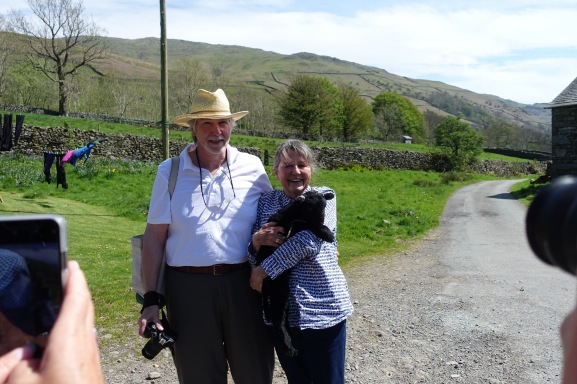
American author Susan Branch (her best-selling memoir, A Fine Romance, is about the English countryside), and her husband Joe Hall, were with our group during several days of our week in the Lake District. They joined us at Town Head Farm, where we were able to cuddle a ten-day old Herdwick lamb. This was Susan’s turn! (P.S. A major motion picture is in the works based on Susan’s memoirs!)
Not far from Town Head Farm is Castlerigg Stone Circle, a Neolithic stone circle dating from about 3000 BC. According to English Heritage, which maintains the site, unlike most of the stone circles in Britain, which date from the later Bronze Age and were constructed as burial monuments, this circle does not contain formal burials. The view of the fells that rise beyond the circle is quite nice.

Spotted at Castlerigg – a schnauzer in a doggie trailer!
The Wordsworth Connection
The beauty of the Lake District inspired authors, poets and artists long before Beatrix Potter began buying farms in the Lake District. Native Cumbrian William Wordsworth was moved by the region’s beauty to compose some of the most famous poems written in the English language. His I Wandered Lonely as a Cloud, written in 1804, describes daffodils he saw “dancing” at the lake named Ullswater.
As a child, Wordsworth attended Hawkshead Grammar School, founded in 1585, which now operates as a museum. Visitors can see the names of generations of pupils who carved their names into the sturdy wooden desks, including a young Wordsworth.
In 1799, Wordsworth and his sister Dorothy moved into an abandoned inn in Grasmere, which they named Dove Cottage. A few years later Wordsworth married his childhood sweetheart from Penrith, Mary Hutchinson, and she moved into Dove Cottage as well. The property, which includes a hillside garden to the rear designed by William and Dorothy, is open to the public. William is said to have composed poetry outdoors in this setting.

Dove Cottage, Grasmere. Wordsworth and his family lived here from 1799 to 1808. “Simple living, high thinking,” said he.

A painting of William Wordsworth’s dog Pepper hangs in one of the main rooms in Dove Cottage. Pepper was given to Wordsworth by Sir Walter Scott. Is this a recognizable breed?

View of the rear of Dove Cottage (white, on left) and adjacent stone buildings, from the cottage’s garden.
Next door to Dove Cottage is the Wordsworth Museum, which contains well-curated displays about the poet, his family and the Romantic period of English literature. At the time of our visit, the museum also had an interesting exhibit on Mary Shelley, who wrote Frankenstein when she was only 18 years old.
In the nearby village center of Grasmere, visitors flock to a charming little shop that sells Grasmere Gingerbread, marketed as “the best gingerbread in the world.” The gingerbread has been baked here since 1854, when it was invented by a Victorian cook named Sarah Nelson. Having tasted some of the freshly baked treat, which is a cross between a cookie (“biscuit” in England) and a cake, it I can attest to its deliciousness.The recipe is top secret.

Exterior of Grasser Gingerbread. The spicy scent of baking gingerbread wafts out of the cottage.

Inside Grasmere Gingerbread, these charming gentlemen were cheerfully wrapping gingerbread in waxed paper imprinted with the company logo.
John Ruskin’s Brantwood
Our group also visited Brantwood, a property in the Lake District that belonged to another influential 19th century writer. John Ruskin spent the last 28 years of his life at Brantwood, perched on a hillside overlooking Coniston Water and surrounded by extensive gardens. Ruskin was also an artist and art critic, a philosopher, and a prominent social reformer.

View of Brantwood from lower hillside garden.

I walked through some of Brantwood’s extensive gardens, in the rain. These mossy roots (on a slippery path!) caught my eye.

Ruskin’s study, still containing his books, paintings and personal effects. The wallpaper is a copy of his original design.
Ruskin’s legacy is described by the Brantwood museum as follows: “John Ruskin left a legacy of influence that stretches from Frank Lloyd Wright to Mahatma Gandhi. He championed many of the tenets of the welfare state, and inspired the founders of the National Health Service, the formation of Public Libraries, the National Trust and many other cornerstones of civil society in the last one hundred years. His influence reached abroad in such areas as women’s education, the minimum wage, child labour, and environmental protection and has served both as a restraining influence on unbridled capitalism and a moral conscience for the nations of the world.”
Looking out a window of Ruskin’s drawing room, I caught a glimpse of the steam-powered Victorian boat (called the Steam Yacht Gondola) operated by the National Trust, which takes visitors out on Coniston Water. It was a rainy and misty day.
There is a lovely restaurant at Brantwood called the Terrace, located in the former coach house. Normally the Terrace only offers lunch, but our resourceful and imaginative guide Mandy Marshall had arranged for us to have dinner there. We enjoyed signature cocktails and a buffet of seasonal dishes, many made with local, fresh vegetables.

A few tables were tucked into the original stalls from when the building was a coach house.

Some of us dined in front of this oversized drawing of John Ruskin at the Terrace.

Rhubarb & damson cocktail – damson gin, Fever Tree tonic and rhubarb swirl. Why not??
A highlight of our afternoon and evening at Brantwood was watching the rain that had fallen all day move out, and the clouds part, over Coniston Water. The view from the (literal) terrace, just outside the Terrace restaurant, kept changing and was breathtaking.
On to Ambleside
On one of our mornings, some of our group walked from the boat pier at the northern tip of Lake Windermere, through the remains of the Galava Roman Fort, along the River Rothay, over an arched stone bridge (called a packhorse bridge), into the busy little village of Ambleside. Here we visited the toy store that was featured in the recently released film Peter Rabbit, saw the Bridge House, a 17th century stone structure spanning the brook that runs through the village, and visited the Armitt Museum and Library

Wooden boats at the Ambleside boat pier, Lake Windermere.
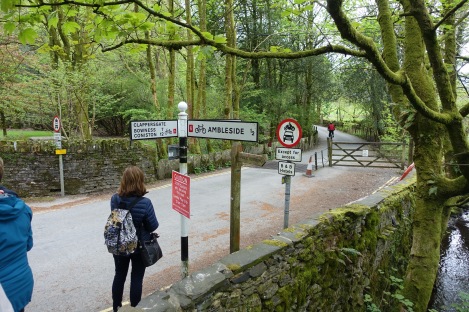
Strolling along the River Rothay near Ambleside.

The Bridge House, in Ambleside. It reminded me of the Mother Goose rhyme about the old woman who lived in a shoe! The property is owned by the National Trust.

Exterior of the Armitt Museum and Library, Ambleside.
The Armitt was founded in 1912 and Beatrix Potter was an early benefactor. There’s an excellent exhibit about her life, but for me the real treat was seeing many of Beatrix’s original botanical watercolors, which she bequeathed to the Armitt, along with her personal set of first edition copies of her “little books” about Peter Rabbit and his friends.
During her twenties, Beatrix became fascinated by mycology, the study of fungi. Her research on the process of germination was presented in the form of a scientific paper (not by her personally, as women were not allowed to present) to the Linnean Society, but it was not accepted. She produced hundreds of botanical and scientific drawings and watercolors, which, according to the Armitt, she herself considered to be among her best work.

Inside the Armitt, in the room where Beatrix Potter’s botanical and mycological drawings and watercolors are on display.
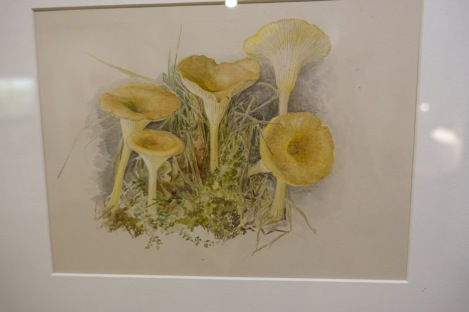

A few of Beatrix Potter’s watercolors of fungi. It was difficult to photograph the paintings in the exhibit because of the glare of overhead lights.

These are some of Beatrix Potter’s personal, first edition copies of her books that she bequeathed to the Armitt.
Lingholm Estate on Derwent Water
Another excursion involved taking a launch from the village of Keswick, across the beautiful Derwent Water, where we had some glorious views of mountains rising beyond.

The launch we rode across Derwent Water.

Stunning views from boat on Derwent Water. Reminded me of my home lake — Lake George, New York.
We disembarked at a dock and then hiked along the lake through forested areas, until we crossed through some sheep pastures and arrived at Lingholm. Beatrix spent nine summer holidays at Lingholm with her family, and it is believed that she based some of her drawings, particularly those of Mr. McGregor’s garden, on gardens at the estate. The privately owned property is now used as a wedding and event venue, and for holiday accommodations. We were able to see much of the first floor interior, including a staircase that Beatrix had painted around 1904.

Beatrix Potter’s painting of Lingholm staircase, around 1904.

The staircase as it appears in 2018.

Exterior of Lingholm, where Beatrix Potter spent nine summer holidays, often staying well into the fall, with her family.
There’s a large, walled garden at Lingholm and The Lingholm Kitchen restaurant, where we enjoyed a locally-sourced dinner through special arrangement by our guide, Mandy Marshall.

This enormous walled garden at Lingholm Estate is a tribute to Mr. McGregor, Peter Rabbit and Beatrix Potter’s friends.
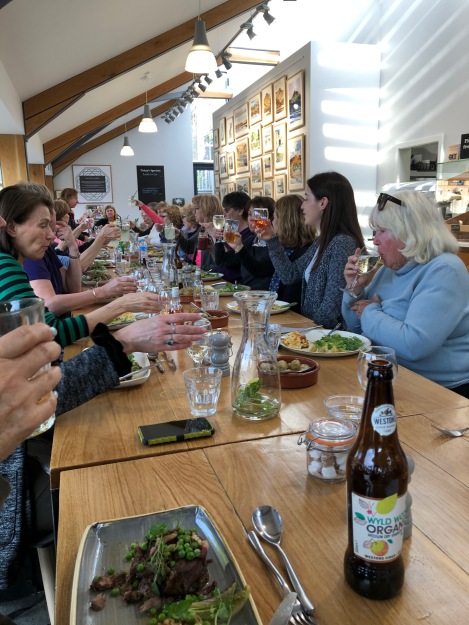
Toasting the chef at Lingholm Kitchen restaurant.

Slow cooked lamb shoulder with peas.
Hill top and Castle Cottage, plus a picnic with Susan Branch!
Of course no visit to the Lake District would be complete without a visit to Hill Top, Beatrix Potter’s 17th century cottage that she filled with antiques, paintings of her own and others, and hand-crafted objects from the Lake District. Beatrix donated the cottage and its belongings to the National Trust, and directed that it was to be left “untenanted and furnished.”

Exterior of main portion of Hill Top.
As mentioned near the top of this post, Susan Branch was with us for some of the time during our week, and she was with us during our private tour of Hill Top, before we convened that afternoon at nearby Castle Cottage for a picnic. Indeed, Susan greeted our group when we first entered!

In the main living area on the first floor. Note Beatrix’s straw hat on the chair, and her boots underneath.

The bedroom at Hill Top. Beatrix rarely slept here, and the bed was bought after she moved into Castle Cottage, the nearby home she shared with her husband. Note the William Morris wallpaper in the “Daisy” pattern, and Beatrix’s hand-embroidered bed valance. On the mantel lintel are the initials WHB and the year 1934, carved by William Heelis to memorialize the couple’s 21st wedding anniversary.

Another view of the bedroom, with a carved Lakeland chest and embroidered samplers. The Windsor chair, and the quilt on the bed (seen in photograph above) are American and came from the estate of Belmount, near Hawkshead, the adopted home of an eccentric American named Rebekah Owen, who became friends with Beatrix.
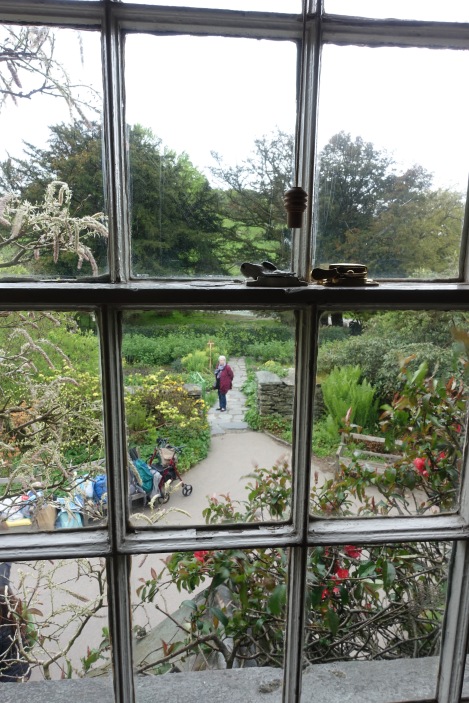
View of front garden out of bedroom window.

A corner of the parlor with some of Beatrix’s collection.

When you enter this room at the rear of the cottage, the view of four large landscape paintings by Beatrix’s brother Bertram is startling, in part, because it is so different than the rest of the cottage.. Beatrix called this the “library.” It was part of a 1906 extension. Beatrix used this room for writing and drawing.
As mentioned above, Mandy Marshall, our incredibly energetic and able Cumbrian guide, lives at Castle Cottage, just across a pasture from Hill Top. Castle Cottage was the home of Beatrix and William Heelis, after they married in 1913 (Beatrix was 47 years old!). Castle Cottage is a private residence, not open to the public, but Mandy graciously invited our group to have a tour of the cottage and property. The garden was also the site of our picnic with Susan Branch and many friends, to celebrate the life and work of Beatrix Potter.

View of Castle Cottage from the public road. When Beatrix purchased the property , the cottage was considerably smaller. She and William Heelis expanded it and lived here for decades.

Susan Branch was enthusiastic in her appreciation for this special event at Castle Cottage.
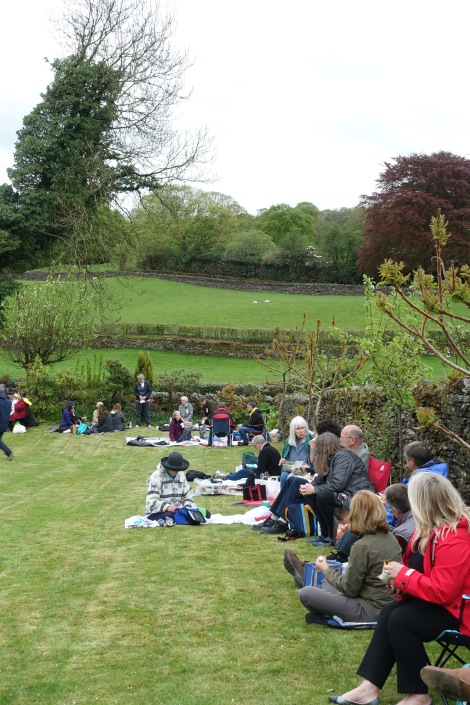
Some of the picnickers on the grounds of Castle Cottage. It was a bit chilly that afternoon but thankfully, the rain held off. Representatives from Victoria magazine were at the picnic and they have told us our picnic will be featured in the magazine’s September, 2018 issue.
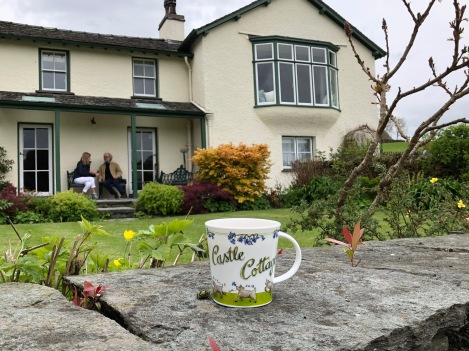
Castle Cottage. In the foreground is a mug (successfully transported by me in bubble wrap and now happily housed in my cupboard at home in New York State!) designed by Susan Branch, to commemorate our picnic on the grounds of Beatrix Potter’s home.
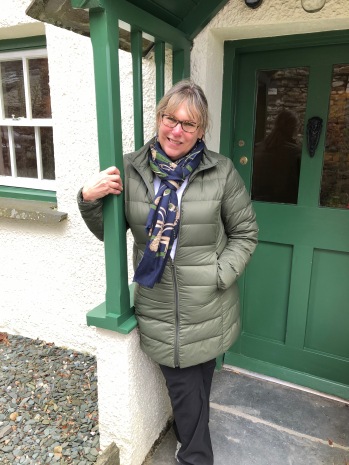
Yours truly, at the door to Castle Cottage, Beatrix Potter’s home in Near Sawrey, Cumbria.

View out of Beatrix’s living room window to her garden, the pastures beyond, and Hill Top Farm. How lucky were we to have the incredible fortune to spend time in Beatrix’s home?

Beatrix Potter and William Heelis married in 1913 and resided at Castle Cottage, in Near Sawrey.
On the day of our Hill Top visit, several of us had the great luck to encounter and spend time with the lovely Sarah, friend of Hill Top gardener Pete. Sarah and Pete live in Near Sawrey and Sarah had several of her personal copies of Beatrix’s “little books” with her. We walked through the village and she showed us Beatrix’s images in the books, and compared them to the actual settings that Beatrix used! Here Sarah is holding up The Tale of Jemima Puddle-Duck, in which the Tower Bank Arms is depicted. The pub is directly next door to Hill Top.

In The Tale of Jemima Puddle-Duck, Kep, the Collie, stands in front of Tower Bank Arms.
 Inside the Tower Bank Arms pub, Near Sawrey.
Inside the Tower Bank Arms pub, Near Sawrey.
Herdwick Limited
Getting back to our tireless guide Mandy Marshall, I’m putting a plug in here about the unique business she has created which supports the local Herdwick farming economy. Through her company, called Herdwick Limited, she purchases wool (fleeces) from National Trust farmers at Herdwick farms in Cumbria. The wool is then washed, combed and spun into worsted wool and woven into tweed, which is cut and sewn into beautifully crafted handbags, totes and home furnishings. Click here for the company Website.
This display was set up in Mandy’s barn at Castle Cottage the day we visited. Mandy and her company have been featured on the British TV series called “Back to the Land,” which “champions the UK’s most inspirational rural entrepreneurs.” The photograph on display is of Tom Storey, Beatrix’s most well-known shepherd, who cared for her Herdwick flocks.
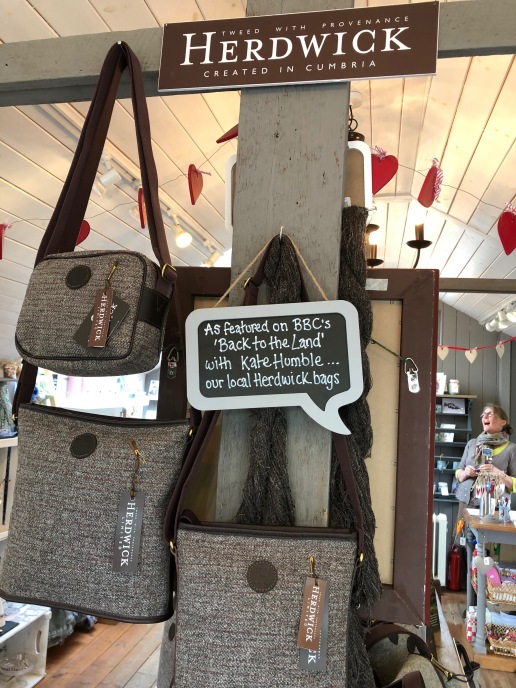
Herdwick bags for sale in a shop in Grasmere.
Hawkshead and Beatrix Potter Gallery
Our group visited a few other sites associated with Beatrix Potter, including the former office of Beatrix’s husband William Heelis, in the village of Hawkshead, which is now operated by the National Trust as the Beatrix Potter Gallery.
Many original Beatrix Potter watercolors are on display within the gallery. Incredibly, also on display is Beatrix’s own copy of her original letter to her governess’s son, sent in 1893, which she used to create the manuscript for The Tale of Peter Rabbit. Although at first Beatrix struggled to find a publisher, and she first printed an edition privately, Frederick Warne and Co. accepted the story and published it in 1902. Following its enormous success, they published another 22 “little books.”
Here is just a small selection of original Beatrix Potter artwork on display at the Beatrix Potter Gallery.

Johnny Town-Mouse

Beatrix Potter fans will recognize this as a frontispiece on the Peter Rabbit “little books.”


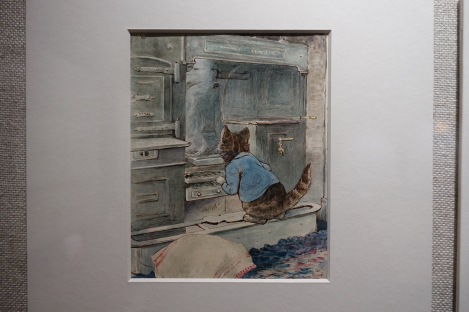
A watercolor used in The Tale of Samuel Whiskers. This image depicts the original kitchen range at Hill Top, which Beatrix replaced with an inglenook fireplace.

This illustration of Pigling Bland at a signpost was based on an actual corner near Beatrix Potter’s Hill Top Farm. We hiked down the road to the location, outside Near Sawrey, and although the signpost has been replaced, we were assured the spot is the original which Beatrix drew.
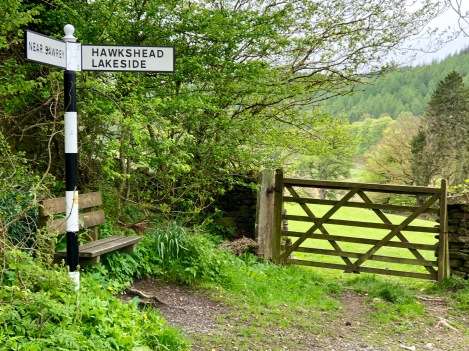
On our way to Pigling Bland’s signpost, we walked past this beautiful farm.
During the month of May, the English bluebells are in bloom across the Lake District. Continuing past the Pigling Bland lamppost we found a wooded area with a trail where we encountered some lovely bluebell patches. Click here to read a short article by the National Trust on bluebells.
Yew Tree Farm
We spent a few delightful hours at Yew Tree Farm, which had been purchased by Beatrix Potter in the 1930s, but is now owned by the National Trust and leased to a family who raises several breeds of sheep, including Herdwick and Swaledale, and Belted Galloway cattle. The exterior of the main cottage at the farm was featured in the 2007 feature film “Miss Potter,” starring Renée Zellweger. Visitors are welcome—click here to learn more.

Yew Tree Farm. This cottage was used as Beatrix Potter’s Hill Top in the 2007 feature film “Miss Potter.”
Well-known local artist Jo McGrath, who lives at the farm, took our group for a walk through sheep and cattle pastures, with the help of her Jack Russell Terrier and goat Skippy.

Ewe and lambs.

Galloway cattle at Yew Tree Farm.

Skippy led the way!
A final note
There have been numerous books and articles written about Beatrix Potter, her life and work. A quick Internet search will bring up many resources. I encourage anyone interested in these topics to read more. You may also wish to check out the Website of the Beatrix Potter Society, which is dedicated to promoting and studying the life and works of Beatrix Potter.
Beatrix was committed to protecting not only the landscape and architecture of the Lake District, but its rural traditions as well. She was a woman far ahead of her times. It is largely because of Beatrix Potter that people today can visit the area and experience the beauty and authentic treasures of this region. And for that, we are truly indebted to her.

Our group, along with Will Benson (at right), his wife Emma, fourth adult from the right in pink shirt, and their daughter Lily, at Town Head Farm. Thanks to Joe Hall for the photo!



























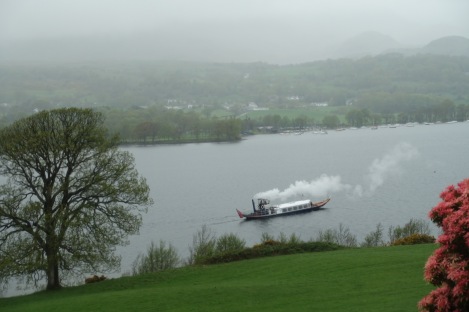





































 Inside the Tower Bank Arms pub, Near Sawrey.
Inside the Tower Bank Arms pub, Near Sawrey.
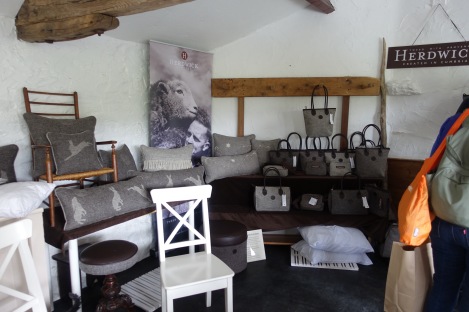











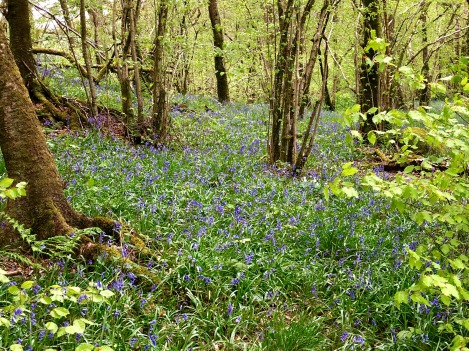







Great job Sandy. So refreshing to re-live our amazing trip on this hot summer day. I look forward to part 2. Lynn
LikeLike
Thank you Lynn! What a memorable trip it was. So many treasured memories with new friends.
LikeLike
Fantastic job summarizing our trip, Sandy! I loved looking through all your photos and the wonderful commentary also. It was an amazing trip with such wonderful people! Amy
LikeLike
Thanks Amy! There was so much to tell that it took me weeks to organize my photos and write the post. Glad you enjoyed it. So many great memories.
LikeLiked by 1 person
How interesting! I would never have guessed Beatrix Potter was a mycologist. And it’s so funny to see that Wordsworth was a child once too – makes me more forgiving of kids being kids.
LikeLike
Thanks Kate! Hopefully your kids aren’t carving their names in their desks at school! Yes, Beatrix was such an amazing woman.
LikeLike
No, thank goodness- but plenty of other rascally antics!
LikeLike
GREAT job, Sandra! It sure brought back lots of fond wonderful memories of our time together on this tour. Thanks so much for doing this and sharing it.
LikeLike
I appreciate your nice comment Judy! I’m hoping to write more about some of the other places we went like Quarry Bank and Levens Hall. Stay tuned!
LikeLike
Oh my, oh my!! …am so impressed with your superb ability to return us to that amazing tour with Mandy our indomitable energetic leader!! Our group will now have, thanks to you Sandy, a permanent remembrance of that delightful sojourn in Beatrix Potter territory!. Am so very grateful to you for the wonderful photos and splendid accompanying comments.
Fondly Doreen
LikeLike
Hi Doreen! Wow— thank you for your lovely, enthusiastic comment on my post. We certainly had some laughs, didn’t we? Yes, the word “indomitable” certainly describes Mandy! She’s a force!! I’m still hoping to say hi to you in August on the Vineyard. I’ll be in touch separately.
LikeLike
Will certainly look forward to your coming in August. Keep me posted as that month is super busy/crazy wit annual fair,Illumination Night etc.etc.!!
LikeLike
Lovely summary of our trip, you captured it beautifully, Sandra. It was fun to be with the group sharing all these experiences. Your photographs are great. Beatrix Potter really was an amazing woman. You wrote about her with such warmth and passion. Thanks!
LikeLike
Hi Betsy! I was just looking at the video of you playing croquet at Levens Hall! I will see if I can email it to you. Many thanks for your nice comments on my blog post. I am so grateful that you put your energies and extensive knowledge of Beatrix Potter into planning and helping lead this trip. I am still hoping to talk to you about your presenting a program on Beatrix Potter in Glens Falls. If you are in Vermont this summer and happen to head over to our neck of the woods, please let me know!
LikeLike
Hi Sandra, your lovely blog and photos….We had some great visits…and you guys left the sunshine in Sawrey…thank you, Mandy
LikeLike
Hi Mandy! I still feel your energy, enthusiasm and love for all things Lake District when I look at my photos and think (daily) of our time with you. We couldn’t have asked for a more prepared, resourceful, and FUN guide! How lucky were we? Hoping to return as soon as possible!! Kisses to Ollie Dog and Stanley!
LikeLike
Sandra, this is a wonderful journal of the trip…so well documented! This supplants my journal. It was a superb trip thanks to Mandy and Betsy and the fantastic group of folks that were so congenial and interesting. Such good memories! I look forward to part II. Thank you so much for sending it out to all of us.
LikeLike
Hi Carol; thank you for your kind comments but I imagine your journal contains many more details and special memories! Wasn’t it the trip of a lifetime? I think of our time in the Lake District every day. Thank you again for the beautifully embroidered totes you gave us. I hope the rest of your trip went well, especially your crossing the pond on the QM2!! It was really lovely getting to know you.
LikeLike
Sandra,I finally had the quiet time to sit and enjoy your wonderful journal. It’s been difficult for me to explain to friends how extraordinary this trip was and how congenial and interesting our fellow travelers were. You have captured both with your photos and commentary. I bought a lovely handmade book at the Silk Mill and have filled it with sketches of our time in this enchanted area . I look forward to Part II of your blog. Thanks for sharing it, Rosemary
LikeLike
Thank you so much Rosemary. I think of our journey every day. I’m so glad you enjoyed the post. I would love to see your sketches.
LikeLike
Hi Sandra,
I’m just back to New Mexico from Seattle after welcoming our newest granddaughter, Mia Elizabeth, who was born July 18th. She is so adorable!! So, I’ve just read every beautifully written word on your blog about our fabulous Beatrix Potter trip in the amazing Lake District! I, too, think about it so often. What a once-in-a-lifetime experience we had, thanks to Mandy and Betsy. It was so much fun to meet you, too! All best wishes, Patty Tharp
LikeLike
Hi Patty. Congrats on the birth of Mia! I’m afraid my photo of the bluebells we found doesn’t quite do them justice. Yes, I think of our trip every day. Just can’t get the Lake District out of my head. Thank you for your sweet comment.
LikeLike
Hi Sandy, can’t wait to see your next post on our Lakes Tour! You are making my scrapbook so easy since you have organized our trip so excellently! Hope to see more soon! Cathy
LikeLike
My husband and I went to England for the first time in order to attend Susan Branch’s picnic and visited all the places you wrote about here except Townend, Derwentwater and Yew Tree Farm. I appreciate your attention to detail and thoroughness in telling us about your trip, especially since I had seriously thought about signing up for the tour myself.
LikeLike
Hi Cathy. Well, we probably crossed paths at Castle Cottage! Do you know about the May 2019 trip to Scotland with the British Whitecroft Tours and Betsy Bray? They’re focusing on Beatrix Potter’s connections to Scotland. Here’s the Website: http://www.whitecrofttours.co.uk. A group of women who were in the group I was with in the Lake District are going. Thanks for your nice comment!
LikeLike
Hi Sandra – me again. Beatrix Potter thoroughly inspired me and continues to do so. I wrote about her and the lady who now lives in Castle Cottage and runs a business making Herdwick Handbags (Beatrix Potter’s favourite type of sheep) and unique to the English Lake District. https://wp.me/p5eFNn-1tJ
LikeLike
Hi Janet! So nice to connect with you. I’ve been on the road the past few days and have written replies to your lovely comments several times but they don’t seem to have posted.
Yes, indeed, I read your excellent piece on Mandy Marshall and her company prior to heading to the Lake District in May. I will also check out the info on your writers’ retreat in Italy.
After reading your post on the WWII silk escape scarves, I saw some in an exhibit at the silk museum in Macclesfield! I’m planning on posting photos when I post about my visit there. Subsequently, I found a reproduction escape scarf in the shop at the Churchill War Rooms, which I purchased and which I treasure. I believe, though, that it is different than the ones you wrote about at the Bodleian Library. Please stay in touch!! Thanks for reaching out!
LikeLiked by 1 person
So nice to speak to / communicate with like minded people!!!
LikeLike
I agree!
LikeLike
We’re so lucky to have Beatrix’s land to explore here in the Lake District, I love having its connection to history right on our doorstep!
LikeLike
Yes…Beatrix was so visionary in her land conservation practices. I sure wish it was closer to MY doorstep!
LikeLike
Pingback: Wiawaka Center for Women, Lake George, NY | Sandra's Town & Country
What a splendid trip, I learnt so much from your post about Beatrix Potter that I wasn’t aware of. Such a shame you couldn’t re-visit the Lake District this year but hopefully you can next year!
LikeLike
What a wonderful account of your visit and such excellent photos and illustrations. I have thoroughly enjoyed reading and viewing every part if it. I spend as much time as possible visiting the lake District (I live in London UK). Thank you for sharing your most fabulous visit!
LikeLike
Thank you, Michelle, for such a lovely and generous comment. I truly appreciate it! I was scheduled to return to the Lake District this past May and stay for a week in Near Sawrey but of course the trip was cancelled because of the Covid-19 situation. I often dream of my time there since it was so magical. I’m certainly hoping to return once the situation settles down. If I may ask —what do you especially recommend doing or seeing in the region? Where do you stay? Thank you and stay well!
LikeLike
Pingback: In the heart of the Lake District, UK — Armitt Library, Wordsworth, Grasmere gingerbread, and more! | Sandra's Town & Country